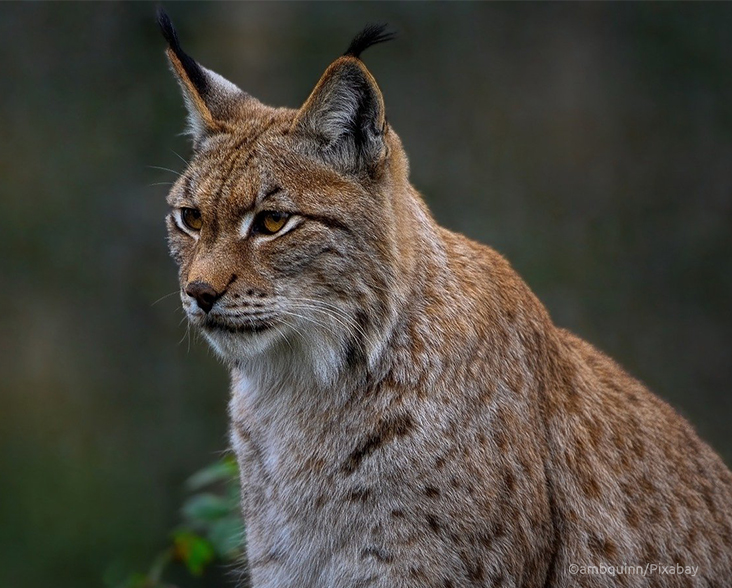Eurasian Lynx
Species Data
Class: Mammalia
Order: Carnivora
Family: Felidae
Scientific Name: Lynx lynx
IUCN Red List status: Least Concern
Description
The Eurasian Lynx is the largest of the four lynx species, generally weighing in at 18-36 kg, reaching lengths of 70-130 cm and standing 60-71 cm tall at the shoulder. All lynx can be distinguished by their long legs and large, padded paws, which are useful adaptations for travelling through snow. Other identifiers include a short tail, a thick ruff of hair framing the face, and long tufts of hair sprouting from the tips of the ears. The coat of the Eurasian Lynx varies in colour from grey or greyish brown to reddish or yellowish, occasionally unmarked but often patterned with spots or rosette markings. Six subspecies of the Eurasian Lynx have been proposed and three more require further investigation and clarification, according to the IUCN.
Behaviour
The Eurasian Lynx is an elusive, solitary and territorial animal mainly active at dawn and dusk. Aided by an excellent sense of hearing and very good eyesight, it is a highly effective predator that can kill prey three to four times its size, preying mostly on medium-sized ungulates such as roe deer, musk deer, reindeer and chamois. Other lynx species favour smaller prey and the Eurasian Lynx will also turn to prey like hares, marmots and birds when ungulates are scarce.
Male home ranges can vary hugely between 100 km2 and 1,000 km2, usually including one or two female home ranges. Calls and scent marks are used to communicate with other lynx. The Eurasian Lynx cannot roar and is generally silent, but it can mew, hiss, growl, purr and “chatter”, also emitting loud mating calls during the mating season. This takes place between February and early April, with cubs usually born around the end of May and beginning of June. Cubs will live with their mother until around 10 months old, at which point they will be left to fend for themselves in the wild.


Habitat
The Eurasian Lynx has a very broad distribution that extends from the French-Swiss border to the Russian Far East. The most northerly individuals live beyond the Arctic Circle, while the most southerly populations are found on the Tibetan Plateau. It is mainly a forest-dweller, but in its Central Asian range it can be found in more open, thinly wooded areas, as well as steppe habitats, rocky hills and mountains. The Eurasian Lynx has been observed at sea level up to elevations of 5,500 metres.
Threats and Conservation
The Eurasian Lynx was downgraded from Near Threatened in 2002 to Least Concern in 2008, owing to its wide range and generally stable population in Europe and large parts of Asia. There are however isolated subpopulations that are either Endangered or Critically Endangered, such as the Balkan Lynx which is estimated to number just 40-50 individuals. The major threats to lynx in Europe are conflicts with hunters or livestock farmers, persecution, habitat loss and fragmentation (mainly due to infrastructure development), poor management structures and accidental mortality.
In some Asian countries, lynx face a major threat from poachers, who either hunt the cats specifically or endanger them indirectly by depleting their prey base. Lynx may also be killed by hunting dogs, accidentally caught in snares set for other animals, or killed in retaliation for taking livestock. As in Europe, habitat loss and fragmentation also occurs in Asia, but is driven additionally by logging activities and resource extraction. The lynx is a protected species across much of its range, but it continues to be hunted legally in Russia and some other countries either for sport or the fur trade.
In Armenia, WLT partner FPWC manages the Caucasus Wildlife Refuge, providing over 30,000 ha of protected habitat for the Eurasian Lynx, Grey Wolf, Caucasian Leopard and Syrian Brown Bear, as well as prey species like the Armenian Mouflon and Bezoar Goat. The mountainous steppe, grasslands and Juniper forests here provide ample hunting and foraging grounds, while FPWC rangers patrol for poachers and engage with local communities to reduce human-wildlife conflict. A new project led by WLT and FPWC aims to plant 700,000 native trees here between 2023 and 2027, restoring 300 ha of degraded habitat along a migratory route for these large mammals.
